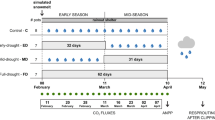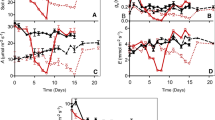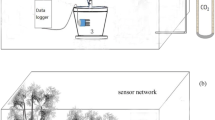Abstract
We conducted a 6-year field manipulation drought experiment in an evergreen Quercus ilex forest where we simulated the drought predicted by GCM and ecophysiological models for the coming decades (an average of 15% soil moisture reduction). We thereby tested the hypothesis that enhanced drought will change Ca, Fe, Mg, Mo and S availability, concentrations and accumulation patterns in Mediterranean ecosystems. The strongest effects of drought occurred in the soil. Drought increased the total soil concentrations of S, the soil extract concentrations of Fe, Mg and S, the Mg saturation in the soil exchangeable complex and tended to increase the percentage base saturation of the soil exchangeable complex. These increased soil concentrations were related to a decrease of plant uptake capacity and not to an increase of soil enzyme activity, which in fact decreased under drier conditions. Drought increased leaf Mg concentrations in the three dominant species although only significantly in Quercus ilex and Arbutus unedo (20 and 14%, respectively). In contrast, drought tended to decrease Ca in Phillyrea latifolia (18%) and Ca and Fe concentrations in the wood of all three species. Drought increased Ca and Fe concentrations in the roots of Quercus ilex (26 and 127%). There was a slight general trend to decrease total biomass accumulation of nutrients that depend on water flux such as Mg, Fe and S. This effect was related to a decrease of soil moisture that reduced soil flow, and to a decrease in photosynthetic capacity, sap flow, transpiration and growth, and therefore plant uptake capacity under drought observed in Quercus ilex and Arbutus unedo. On the contrary, drought increased Mo accumulation in aboveground biomass in Phillyrea latifolia and reduced Mo accumulation in Arbutus unedo by reducing growth and wood Mo concentrations (51%). Phillyrea latifolia showed a great capacity to adapt to drier conditions, with no decrease in growth, an increase of Mo uptake capacity and a decrease in leaf Ca concentration, which was related to a decrease in transpiration under drought. The results indicate asymmetrical changes in species capacity to accumulate these elements, which are likely to produce changes in inter-specific competitive relations among dominant plant species and in their nutritional quality as food sources. The results also indicate that drought tended to decrease nutrient content in aboveground biomass, mainly through the decrease in growth and transpiration of the most sensitive species and caused an increase in the availability of these nutrients in soil. Thus, drought decreased the ecosystem’s capacity to retain Mg, Fe and S, facilitating their loss in torrential rainfalls.










Similar content being viewed by others
References
Abollino O, Aceto M, Malandrino M et al (2003) Heavy metals in agricultural soils from Piedemont, Italy. Distribution, speciation and chemometric data treatment. Chemosphere 49:545–557
Albasel N, Pratt PF (1989) Guidelines for molybdenum in irrigation waters. J Environ Qual 18:259–264
Antolín MC, Sánchez Díaz M (1992) Photosynthetic nutrient use efficiency, nodule activity and solute accumulation in drought-stressed alfalfa plants. Photosynthetica 27:595–604
Armbruster M, MacDonald J, Dise NB et al (2002) Throughfall and output fluxes of Mg in European forest ecosystems: a regional assessment. For Ecol Manage 164:137–147
Arocena JM, Glowa KR (2000) Mineral weathering in ectomycorrhizosphere of subalpine fir (Abies lasiocarpa Hook. Nutt.) as revealed by soil solution composition. For Ecol Manage 133:61–70
Baranowski P, Usowicz B, Walczak RT et al (2005) In: Baranowski P, Usowicz B (eds) Evapotranspiration into the boundary layer of the atmosphere. Lublin
Bargagli R, Brown DH, Nelli L (1995) Metal biomonitoring with mosses: procedures for correcting for soil contamination. Environ Pollut 89:169–175
Blaser P, Zimmermann P, Luster J et al (2000) Critical examination of trace elements enrichments and depletions in soils: As, Cr, Cu, Ni, Pb, and Zn in Swiss forest soils. Sci Total Environ 249:257–280
Browder JF, Niemiera AX, Harris JR et al (2005) Growth response of container-grown pin oak and Japonesa maple seedlings to sulfur fertilization. Hortscience 40:1524–1528
Campo J, Maass JM, Jaramillo VJ et al (2000) Calcium, potassium, and magnesium cycling in a Mexican tropical dry forest ecosystem. Biogeochemistry 49:21–36
Carreira JA, Sánchez-Vázquez F, Niell FX (1992) Short-term and small-scale patterns of post-fire regeneration in a semi-arid dolomitic basin of Southern Spain. Acta Oecol 12:241–253
Chapman HD (1965) Cation-exchange capacity. In: Black CA (ed) Methods of soil analysis—chemical and microbiological properties. Agronomy 9:891–901
Comerford NB, Cropper WP, Li H et al (2006) Soil supply and nutrient demand (SSAND): a general nutrient uptake model and an example of its application to forest management. Can J Soil Sci 86:665–673
Dabkowska-Naskret N (2000) Status of iron in alluvial soils from the Wisla River Valley, Poland. J Plant Nutr 23:1549–1557
Dambrine E, Carisey N, Pollier B et al (1992) Mineral element dynamics in the xylem sap of 30-year old spruce. Ann Sci For 49:489–510
Diehl S, Berger S, Wohrl R (2005) Flexible nutrient stoichiometry mediates environmental influences on phytoplankton and its resources. Ecology 86:2931–2945
Dambrine E, Carisey N, Pollier B et al (1993) Effects of drought on the yellowing status and the dynamics of mineral elements in the xylem sap of declining spruce (Picea abies L.). Plant Soil 150:303–306
Fenn LB, Feagley S (1999) Review of beneficial uses of calcium and ammonium salts for stimulating plant growth and metabolite translocation. Commun Soil Sci Plant Anal 30:2627–2641
Fullin EA, Zangrande MB, Lani JA et al (1999) Nitrogen and molybdenum fertilization in dry bean Ander irrigated conditions Pesqui. Agropecu. Bras. 34:1145–1149
Grabarova S, Martinkova M (2001) Changes in mineral nutrition of Norway spruce (Picea abies) [L.] Karst.) under the impact of drought. Ekologia-Bratislava 20:40–60
Gulpen M, Feger KH (1998) Magnesium and calcium nutrition of spruce on high altitude sites – yellowing status effects of fertilizer application. Zeitschrift Fur Pflanzenernahrung Und Bodenkunde 161:671–679
Gupta UC (1997) Symptoms of molybdenum deficiency and toxicity in crops. In: Gupta UC (ed) Molybdenum in agriculture. Cambridge University Press, Cambridge
Gupta UC, Leblanc PV, Chipman EW (1990) Effect of molybdenum applications on plant molybdenum concentration and crop yields on sphagnum peat soils. Can J Soil Sci 70:717–721
Gupta UC, Mackay DC (1986) Procedure for determination of exchangeable copper and molybdenum in podzolic soils. Soil Sci 101:93–97
Henkin Z, Seligman NG, Kafkafi U et al (1998) Effective growing day’s: a simple predictive model of response of herbaceous plant growth in Mediterranean ecosystems to variation in rainfall and phosphorous availability. J Ecol 86:137–148
Hermans C, Verbruggen N (2005) Physiological characterization of Mg deficiency in Arabidopsis thaliana. J Exp Bot 56:2153–2161
Hu YC, Schmidhalter U (2005) Drought and salinity: a comparison of their effects on mineral nitrition of plants. J Plant Nutr Soil Sci 168:541–549
Hu YC, Burucs Z, von Tucher S et al (2007) Short-term effects of drought and salinity on mineral nutrient distribution along growing leaves of maize seedlings. Environ Exp Bot 60:268–275
Ichinose H, Nakamizo M, Wariishi H et al (2002) Metabolic response against sulphur-containing heterocyclic compounds by the lignin-degrading basidiomycete Coriolus versicolor. Appl Microbiol Biotechol 58:517–526
Inclan R, Gimeno BS, Dizengremel P et al (2005) Compensation processes of Aleppo pine (Pinus halepensis Mill.) to ozone exposure and drought stress. Environ Pollut 137:517–524
IPCC (2001) Climate change (2001). The scientific basis. Contribution of working group I. Third assessment report of intergovernmental panel on climate change. In: Hougton JT, Dung Y, Griggs DJ, Noguer M, Van der Linden PJ, Dui X, Maskell K, Johnson CA (eds). Cambridge University Press, Cambridge
IPCC (2007) Climate change (2007). The physical science basis. Contribution of working group I. Fourth assessment report of the intergovernmental panel on climate change. In: Solomon S, Qin D, Manning M, Chen Z, Marquis M, Averyt KB, Tignor M, Miller HL (eds). Cambridge University Press, Cambridge
Itanna F (2005) Sulfur distribution in five Ethiopian Rift Valley soils under humid and semi-arid climate. J Arid Environ 62:597–612
Jaenike J, Markow TA (2003) Comparative elemental stoichiometry of ecologically diverse Drosophila. Funct Ecol 17:115–120
Kaiser BN, Gridley KL, Brady JN et al (2005) The role of molybdenum in agricultural plant production. Ann Bot 96:745–754
Kruger FJ (1979) South African heathlands. In: Specht RL (ed) Ecosystems of the world. Heathlands and related shrublands. Elsevier, Amsterdam, pp 19–88
Laing W, Greer D, Sun O et al (2000) Physiological impacts of Mg deficiency in Pinus radiata: growth and photosynthesis. New Phytol 146:47–57
Lang F, Kaupenjohann M (2003) Immobilisation of molybdate by iron oxides: effects of organics coatings. Geoderma 113:31–46
López-Serrano FR, de las Heras J, González-Ochoa AI et al (2005) Effects of silvicultural treatments and seasonal patterns on foliar nutrients in young post-fire Pinus halepensis forest stands. For Ecol Manage 210:321–336
Makino W, Cotner JB, Sterner RW et al (2003) Are bacteria more like plants or animals? Growth rate and resource dependence of bacterial C:N:P stoichiometry. Funct Ecol 17:121–130
Marschner H (1995) The mineral nutrition of higher plants, 2nd edn. Academic Press, London
Martínez-Vilalta J, Mangirón M, Ogaya R et al (2003) Sap flow of three co-occuring Mediterranean woody species under varying atmospheric and soil water conditions. Tree Physiol 23:747–758
Mayor X, Rodà F (1994) Effects of irrigation and fertilization on stem diameter growth in a Mediterranean holm oak forest. For Ecol Manage 68:119–126
Montès N, Bertaudière-Montes V, Badri W et al (2002) Biomass and nutrient content of semi-arid mountain ecosystem: the Juniperus thurifera L. woodland of Azzaden Valley (Morocco). For Ecol Manage 166:35–43
Nechwatal J, Obwald WF (2003) Evidence for the involvement of biotic factors in the yellowing disease of Norway spruce (Picea abies L. Karst.) at higher elevations of the Babarian forest. Plant Soil 254:403–414
Neunhäuserer C, Berreck M, Insam H (2001) Remediation of soils contamined with molybdenum using soil amendments and phytoremediation. Water Air Soil Pollut 128:85–96
Ngai JT, Jefferies RJ (2004) Nutrient limitation of plant growth and forage quality in Artic coastal marshes. J Ecol 92:1001–1010
Ogaya R, Peñuelas J (2007) Tree growth, mortality, and above-ground biomass accumulation in a holm oak forest under a five-year experimental field drought. Plant Ecol 189:291–299
Ogaya R, Peñuelas J, Martinez-Vilalta J et al (2003) Effect of drought on diameter increment of Quercus ilex, Phillyrea latifolia, and Arbutus unedo in a holm oak forest of NE Spain. For Ecol Manage 180:175–184
Orgeas J, Ourcival J-M, Bonin G (2002) Seasonal and spatial patterns of foliar nutrients in cork oak (Quercus suber L.) growing on siliceous soils in Provence (France). Plant Ecol 164:201–211
Ouimet R, Camire C (1995) Foliar deficiencies of sugar maple stands associated with soil cation imbalances in Quebec Appalachians. Can J Soil Sci 75:169–175
Papatheodorou EM, Stamou GP (2004) Nutrient attributes of tissues in relation to grazing in an evergreen sclerophyllous shrub (Quercus coccifera L.) dominating vegetation in Mediterranean-type ecosystems. J Arid Environ 59:217–227
Peñuelas J, Filella I, Comas P (2002) Changed plant and animal cycles from 1952–2000 in Mediterranean region. Global Change Biol 8:531–544
Peñuelas J, Filella I, Sabate S et al (2005) Natural systems: terrestrial ecosystems. In: Llebot JE (ed) Report on climate change in Catalonia. Institut d’Estudis Catalans, Barcelona, pp 517–553
Piñol J, Terradas J, Lloret F (1998) Climate warming, wildfire hazard, and wildfire occurrence in coastal eastern Spain. Clim Change 38:347–357
Pintro JC, Taylor GJ (2005) Calcium requirement in the background nutrient solution on growth of wheat plants using the relative addition rate technique. J Plant Nutr 28:551–565
Porter JR (1986) Evaluation of washing procedures for pollution analysis of Ailanthus altissima leaves. Environ Pollut Ser B Chem Phys 12:195–202
Protocic N, Cosic T, Pillas I (2005) The influence of climate and soil properties on calcium nutrition and vitality of silver fir (Abies alba Mill.). Environ Pollut 137:596–602
Rashid A, Ryan J (2004) Micronutrient constrains to crop production in soil with Mediterranean-type characteristics: a review. J Plant Nutr 27:959–975
Rodenkirchen H (1998) Evidence for a nutritional disorder of Oxalis acetosella L. on acid forest soils. II Diagnostic field experiments and nutrient solution studies. Plant Soil 199:153–166
Sabaté S, Gracia C, Sánchez A (2002) Likely effects of climate change on growth of Quercus ilex, Pinus halepensis, Pinus pinaster, Pinus sylvestris and Fagus sylvatica forests in the Mediterranean region. For Ecol Manage 162:23–37
Sardans J, Peñuelas F (2004) Increasing drought decreases phosphorus availability in an evergreen Mediterranean forest. Plant Soil 267:367–377
Sardans J, Peñuelas J (2005) Drought decreases soil enzyme actiyity in a Mediterranean holm oak forest. Soil Biol Biochem 37:455–461
Sardans J, Peñuelas J (2007) Drought changes phosphorus and potassium accumulation patterns in an evergreen Mediterranean forest. Funct Ecol 21:191–201
Sardans J, Rodà F, Peñuelas J (2004) Phosphorus limitation and competitive capacities of Pinus halepensis and Quercus ilex ssp. rotundifolia on different soils. Plant Ecol 174:305–317
Sardans J, Rodà F, Peñuelas J (2005a) Effects of water and a nutrient pulse supply on Rosmarinus officinalis growth, nutrient content and flowering in the field. Environ Exp Bot 53:1–11
Sardans J, Peñuelas J, Rodà F (2005b) Changes in nutrient use efficiency, status and retranslocation in young post-fire regeneration Pinus halepensis in response to sudden N and P input, irrigation and removal of competing vegetation. Trees 19:233–250
Sardans J, Peñuelas J, Rodà F (2006a) Plasticity of leaf morphologic traits, leaf nutrient content, and water capture in the Mediterranean evergreen oak Quercus ilex subsp. ballota in response to fertilization and changes in competitive conditions. Ecoscience 13:258–270
Sardans J, Rodà F, Peñuelas J (2006b) Effects of a nutrient pulse supply on nutrient status of the Mediterranean trees Quercus ilex subsp. ballota and Pinus halepensis in different soils and under different competitive pressure. Trees 20:619–632
Schinner F, Öhlinger R, Kandeler E et al (1996) Methods in soil biology. Springer Lab Manual, Berlin, Heidelberg, New York, Tokyo, pp 426
Schulte M, Herschybach C, Rennenberg H (1998) Interactive effects of elevated atmospheric CO2, mycorrhization and drought on long-distance transport of reduced sulphur in young pedunculate oak trees (Quercus robur L.). Plant Cell Environ 21:917–926
Shenker M, Chen Y (2005) Increasing iron availability to crops: fertilizers, organo-fertilizers, and biological approaches. Soil Sci Plant Nutr 51:1–17
Sinhg B, Singh G (2006) Effects of controlled irrigation on water potential, nitrogen uptake and biomass production in Dalbergia sissoo seedlings. Environ Exp Bot 55:209–219
Specht RL (1979) The sclerophyllous (heath) vegetation of Australia: the eastern and central states. In: Specht RL (ed) Heathlands and related shrublands. Elsevier, Amsterdam, pp 125–210
Takagi S, Nagai R (1992) Several aspects of current research into the role of calcium in plant physiology. Bot Mag-Tokyo 105:687–697
Turner BL, Haygarth PM (2001) Biogeochemistry—phosphorus solubilization in rewetted soils. Nature 411:258
Vandecasteele B, Meers E, Vervaeka P et al (2005) Growth and trace metal accumulation of two Salix clones on sediment-derived soils with increasing contamination levels. Chemosphere 58:995–1002
van Elteren JT, Budic B (2004) Insight into the extractability of metals from soils using an implementation of the linear adsorption isotherm model. Anal Chim Acta 514:137–143
VankovaRadeva RV, Yaneva IA, Baidanova VD et al (1997) Molybdenum-induced increase in frost tolerance of winter wheat grown on acidic soil. Russ J Plant Physiol 44:204–209
Wang Zh, Li SH, Vera CL et al (2005) Effects of water deficit and supplemental irrigation on winter wheat growth, grain yield and quality, nutrient uptake, and residual mineral nitrogen in soil. Commun Soil Sci Plant Anal 36:1405–1419
Weber-Blaschke G, Claus M, Rehfuess KE (2002) Growth and nutrition of ash (Fraxinus excelsior L.) and sycamore (Acer pseudoplatanus L.) on soils of different base saturation in pot experiments. For Ecol Manage 167:43–56
Yavitt JB, Wright SJ, Wieder RK (2004) Seasonal drought and dry-season irrigation influence leaf-litter nutrients and soil enzymes in a moist, lowland forest in Panama. Austral Ecol 29:177–188
Yin Y, Impellitteri CA, You SJ et al (2002) The importance of organic matter distribution and extract soil:solution ratio on the desorption of heavy metals from soils. Sci Total Environ 287:107–119
Acknowledgements
This research was supported by Spanish Government CGL2004-01402/BOS and CGL2006-04025/BOS grants, the EC Integrated FP6 ALARM (GOCE-CT-2003-506675), FP6 NEU NITROEUROPE (GOCE017841) Projects, and a Fundación BBVA 2004 and a Catalan government SGR2005-00312 grant. This experiment complied in all its aspects the laws of Spain and the European Union.
Author information
Authors and Affiliations
Corresponding author
Rights and permissions
About this article
Cite this article
Sardans, J., Peñuelas, J. & Ogaya, R. Drought’s impact on Ca, Fe, Mg, Mo and S concentration and accumulation patterns in the plants and soil of a Mediterranean evergreen Quercus ilex forest. Biogeochemistry 87, 49–69 (2008). https://doi.org/10.1007/s10533-007-9167-2
Received:
Accepted:
Published:
Issue Date:
DOI: https://doi.org/10.1007/s10533-007-9167-2




